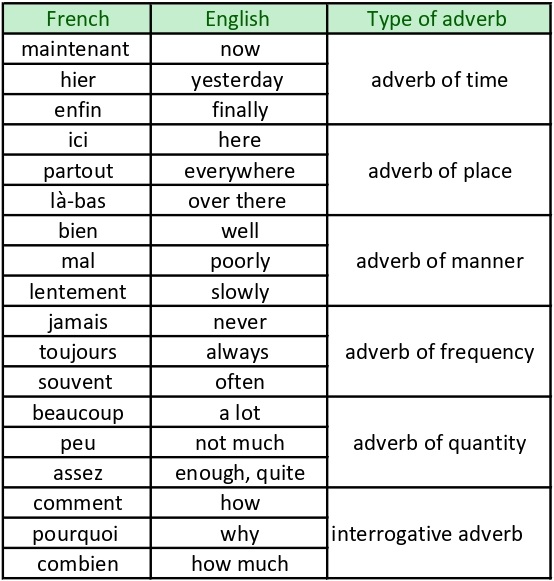French adverbs – Les adverbes en francais
First of all, let’s start with understanding what an adverb is. It’s one of the eight parts of speech and its role is to modify and describe a verb, an adjective, a preposition or an adverb. An adverb gives information about when, where, how, how often something was, is, would, should or will be done. Compared to the other parts of the speech that have to agree in number and gender, French adverbs are invariable, which means their spelling doesn’t change. The only things you need to know about French adverbs is how they are formed and specific placement rules.
How to form French adverbs
As a general rule, the adverb is formed by adding – ment, same as in English when you add – ly to adjectives to form an adverb. For example “honest” + – ly = “honestly”.
The same rule is applied in French. By adding the suffix – ment you can transform an adjective into an adverb.
poli (polite) → poliment (politely)
However, there are always some more rules and exceptions
-
- If an adjective ends in a vowel, simply add – ment to the masculine form to form the adverb.
vrai(true) → vraiment (truly) - Simply add – ment to the feminine form to form the adverb, if an adjective ends in a consonant.
lent(m) → lente(f) → lentement (slow/slowly) - If an adjective ends in – ant or – ent, remove the ending and add – amment or – emment.
– ant → – amment passionant → passionamment (passionate/ passionately)
– ent → – emment intelligent → intelligemment (intelligent/ intelligently)
- If an adjective ends in a vowel, simply add – ment to the masculine form to form the adverb.
There are some exceptions with irregular adverbs, those that don’t follow any rules:
bon (m) → bonne (f) → bien (well)
mauvais (m) → mauvaise (f) → mal (badly)
meilleur (m) → meilleure (f) → mieux (better)
With these adjectives, you would normally use the 2nd rule, however the rules don’t apply on these ones.
Here’s a spreadsheet with different types of adverbs with examples

Where to place French adverbs
There are two general rules when it comes to understanding the placement of adverbs in the French language.
-
- If the adverb modifies a verb, it is placed after the conjugated verb.*J’ai bien mangé. → I ate well.Je pars loin. → I’m leaving far (away).
*If the verb is in a compound tense, then the adverb has to be placed after the auxiliary verb. Also note that in negative sentences the adverb is placed after “pas”.
Je n’ai pas bien mangé. → I didn’t ate well.
Je ne pars pas loin. → I’m not leaving far.
- If the adverb modifies a verb, it is placed after the conjugated verb.*J’ai bien mangé. → I ate well.Je pars loin. → I’m leaving far (away).
- It sits right before, If the adverb modifies an adjective or another adverb.
-
- J’ai trop bien mangé. → I ate very well.
-
- Je pars trop loin. → I’m leaving very far (away).
And this is it! Make sure to practice forming adverbs, but don’t forget that they are still a separate form of speech, so you will have to learn them by heart. Good luck!
